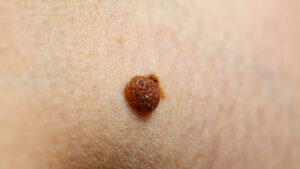This summer, many patients have been asking me about the safety of daily sunscreen use. Why? A widely-publicized, preliminary FDA study published in the spring of 2019, in the Journal of the American Medical Association showed that chemical sunscreen ingredients are absorbed through the skin and found at higher levels in the blood than previously believed.
Chemical sunscreens (such as those in the FDA study) protect our skin by absorbing ultraviolet (UV) rays before they can harm skin cells. These chemicals work after penetrating the skin. This differs from physical sunscreens, namely zinc oxide and titanium dioxide, which work like a “blanket” or “shield” to actually reflect harmful UV rays from the skin’s surface. Zinc oxide and titanium dioxide are not absorbed into the skin because of their large particle size and are naturally broad-spectrum sunscreens, blocking both UVA and UVB rays.
In the study, researchers asked 24 volunteers to apply one of four sunscreens (two sprays and two lotions) to 75 percent of their bodies every 2 hours, 4 times a day for 4 days—the same amount recommended for proper use. The sunscreens used in the study contained four common chemical ingredients: Avobenzone, Oxybenzone, Octinoxate, and Ecamsule (Mexoryl).
What were the results?
Blood tests showed that after just one day of using these products, the volunteers’ blood levels of all four chemicals exceeded the FDA’s testing threshold; for Oxybenzone, that level was exceeded in just 2 hours. Spray-on sunscreens resulted in the highest blood levels. The concentration of these chemicals in the blood continued to rise over the four-day study period and the findings were published in the Journal of the American Medical Association in May 2019.
What does this mean?
Maybe nothing. We don’t know if long-term use of chemical sunscreens are in any way harmful to us since this is the first study to measure blood levels of these substances after applying them to the skin. These same chemicals have also been used in most available sunscreens for many years. They were previously even known to be found in breast milk and urine after normal application. The FDA’s call for further research in response to these recent findings will hopefully shed more light on the long term safety of these products.
What to do now?
Keep using sunscreen and protect your skin. Remember, we do know that skin cancer remains the most common type of human cancer and that sunscreen use has reduced the incidence of all types of skin cancer, including melanoma—the deadliest form of skin cancer and the most common cause of cancer-related death in a person between the age of 25 and 40.
So if you have a choice, use an all zinc oxide or titanium dioxide-containing sunscreen every day and read the label so you know which ingredients are in your sunscreen. Select cream or lotion formulations instead of sprays if possible, since the highest blood levels of chemical sunscreen ingredients were seen in those subjects who used spray sunscreens. The best sunscreens have “broad spectrum (UVA/UVB)” on the label and an SPF of at least SPF 30. Some reliable brands include ELTA MD, Skinceuticals and Colorescience, all available at Golden State Dermatology. Finally, remember that hats and long-sleeved clothing and pants will almost always provide superior sun protection and that you should never rely solely on your sunscreen (no matter how high the SPF) to avoid sunburn.
Have fun and keep safe in the sun this summer!







